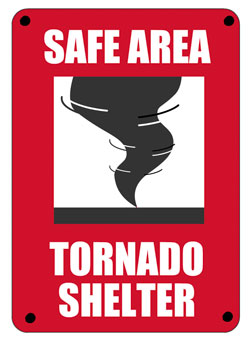- Tornadoes
Tornado refuge area (shelter)
The destruction of structures and threat to life during tornadoes is usually caused by a combination of three factors: Wind-induced forces, changes in atmospheric pressure, and debris (airborne) impact.
There has been enough study on the factors above, and there are effective engineering and architectural considerations that can make a building safe during a tornado.
Buildings with heavy masonry and concrete materials that are well tied to other parts of the structure tend to withstand extreme winds. The weight and strength of the walls can stop flying debris that often causes property damage. They also resist the uplift and lateral loads caused by excessive winds, making the building a better refuge area.
Airborne debris moves in all directions, and refuge areas must have the capacity to shield people from the threat of flying debris. It is the reason basements are the best places to seek refuge during tornadoes. For buildings without basements, the lowest roof, first floor, interior, or most enclosed places are safer.
 Usually, building inspectors can assist you to locate, improve and utilize the best available refuge area in older and more vulnerable buildings. Long roof spans and large volume open areas such as gymnasiums, auditoriums, and cafeterias must be avoided. Also, areas with large expanses of glass and skylights must be avoided.
Usually, building inspectors can assist you to locate, improve and utilize the best available refuge area in older and more vulnerable buildings. Long roof spans and large volume open areas such as gymnasiums, auditoriums, and cafeterias must be avoided. Also, areas with large expanses of glass and skylights must be avoided.
Make sure you know this preparation tip before a tornado visits. It is a good idea to put “Refuge Area” signs in school or public buildings, because many times, there is very little lead time (The current average lead-time for tornado warnings is 13 minutes) to take refuge.
